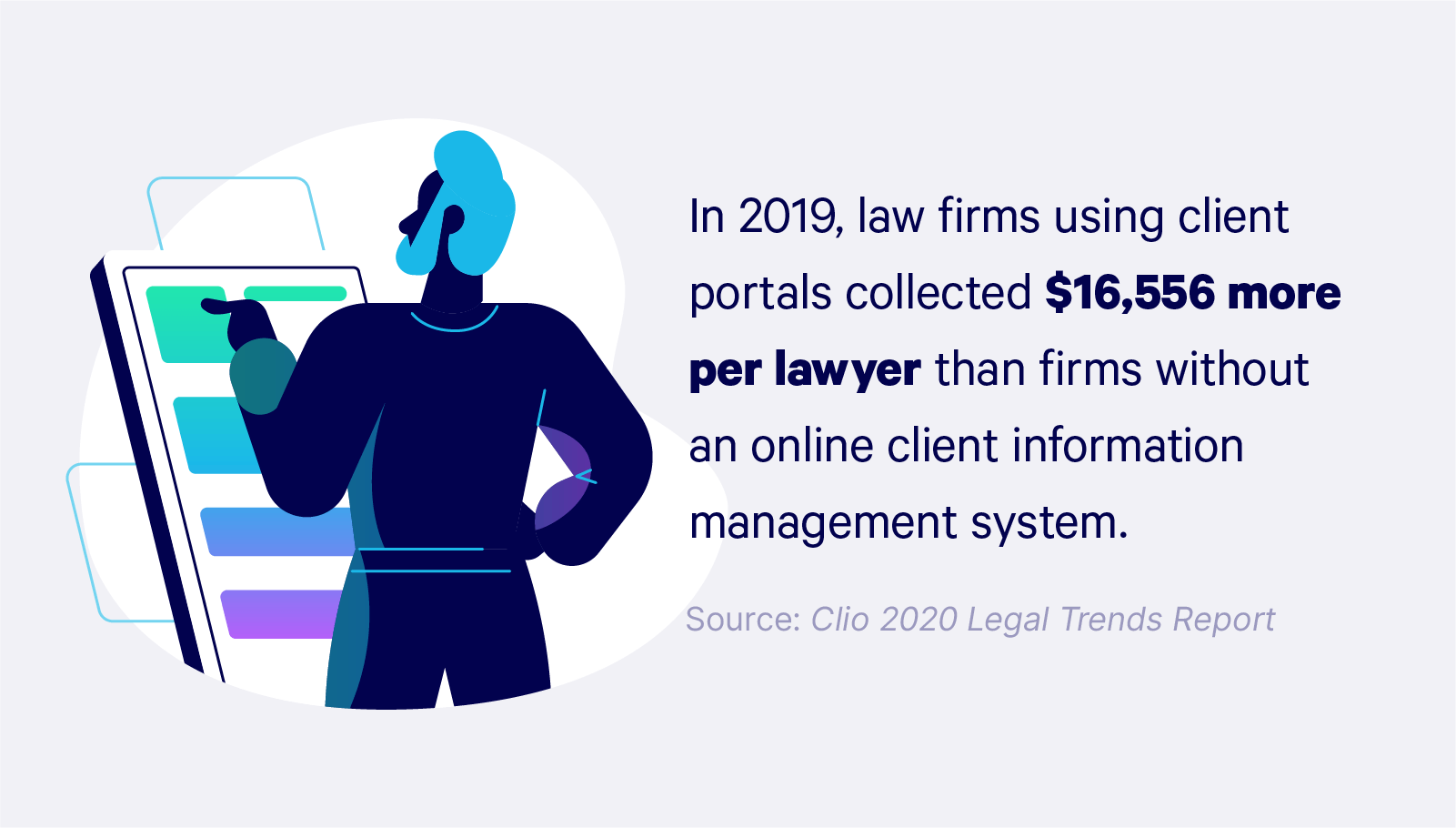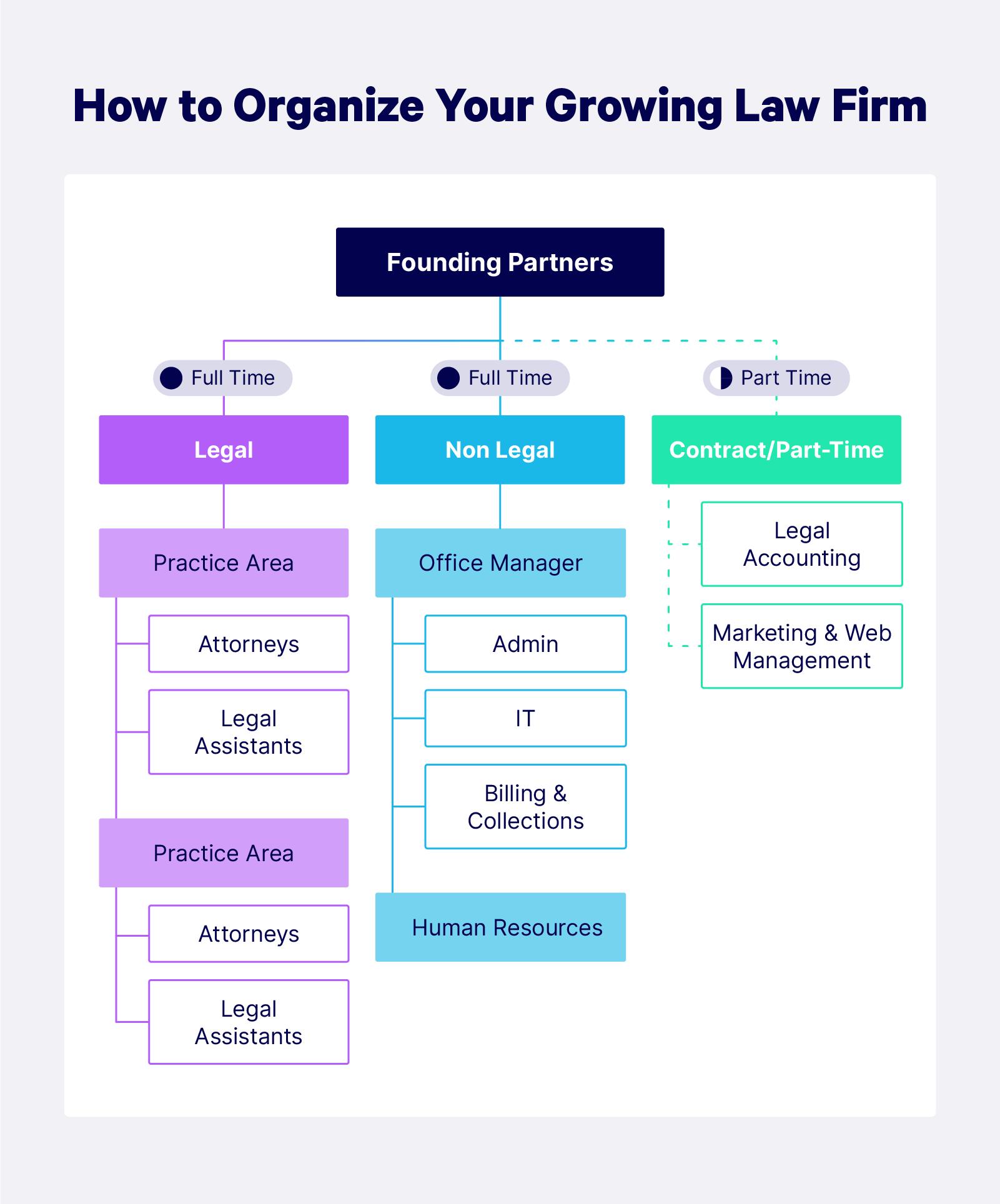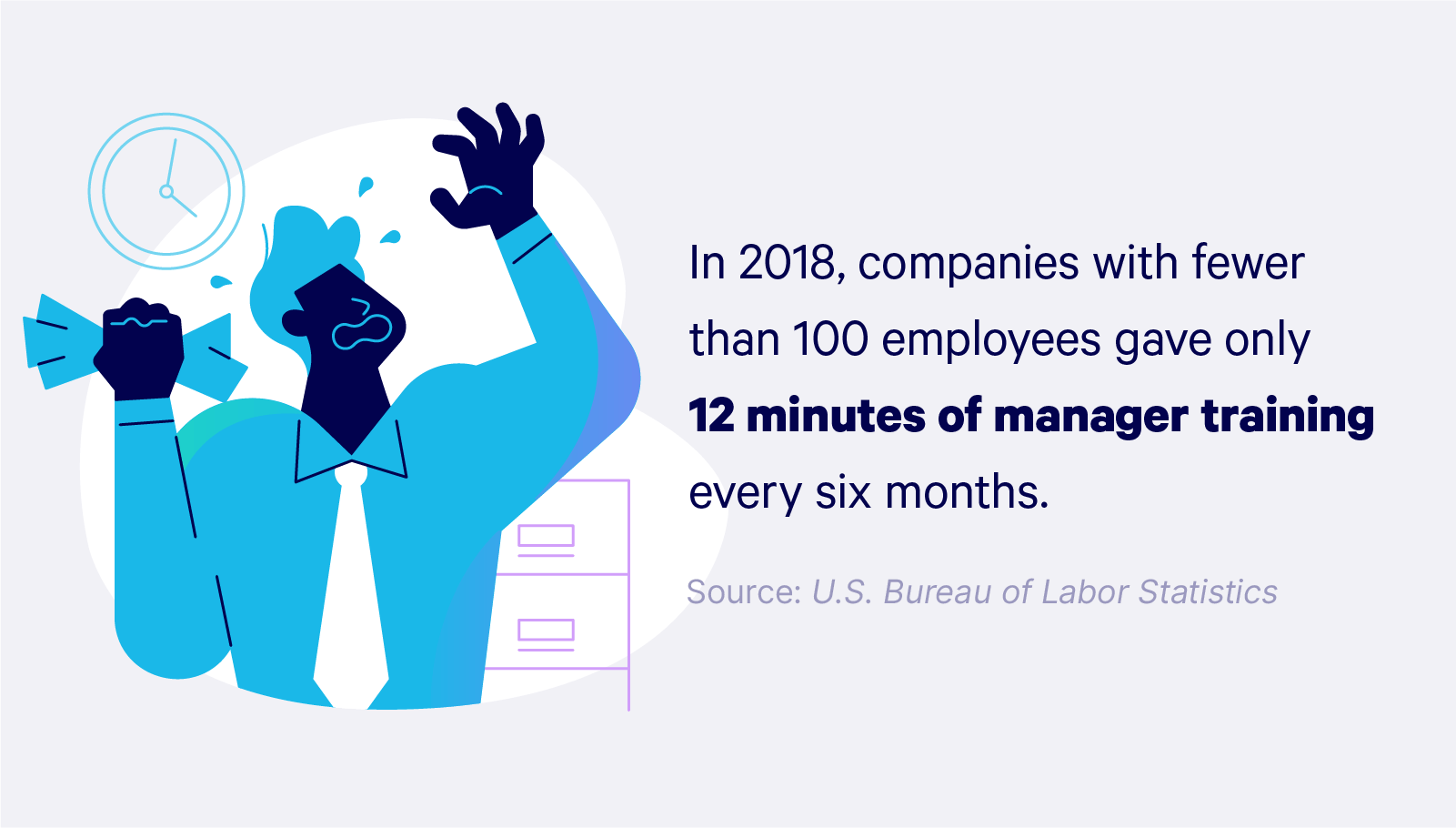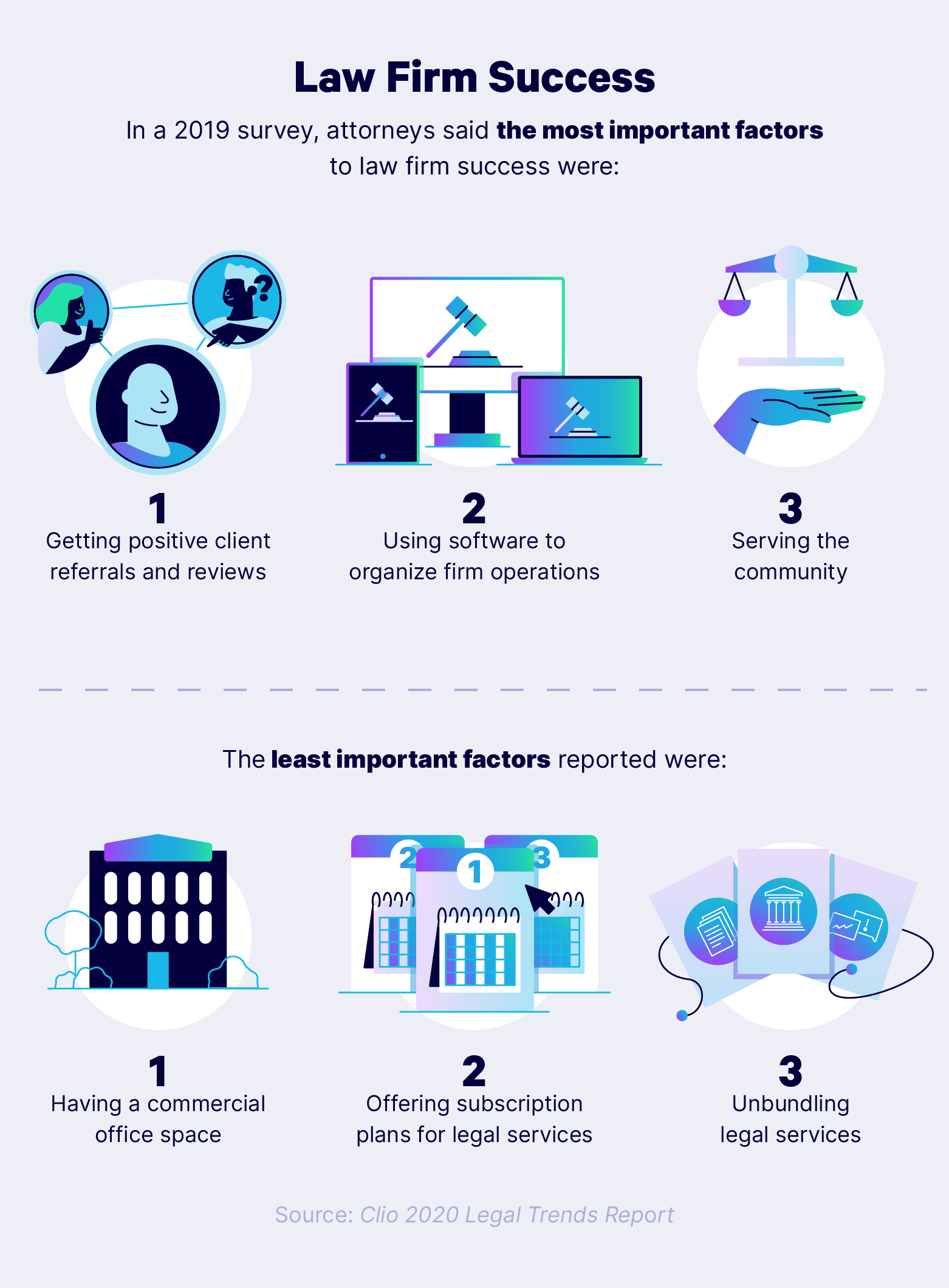The Ultimate Guide: How to Grow a Law Firm
Table of Contents
- Writing a Growth Strategy for How to Grow a Law Firm
- Setting Goals for Your Firm’s Growth
- Analyzing Your Firm’s Target Market for Growth
- Designing an Agile Company Infrastructure
- Defining and Organizing Roles Are Essential in How to Grow a Law Firm
- Business Training for Attorneys
- Business Development Basics for How to Grow a Law Firm
- Essentials of Law Firm Marketing
Protect your business today!
Get a QuoteProtect your business today!
Get a QuoteWhen you own and operate your own law firm, it’s not enough to be a great attorney — you also need financial, marketing, management, HR, and even sales skills in order to run a successful small firm like a business. If you want to intimately understand how to grow a law firm, it’s vital that you put the right relationships, legal technology, and practices into place. Unless you managed to pick up a business degree on your way to your J.D., there’s a lot you’ll need to brush up on in order to successfully scale your law firm.
There’s plenty of merit to figuring things out as you go along, but when your growing law firm is at stake, it’s essential that you do everything in your power to prevent costly mistakes and minimize your firm’s liability. From conducting market and financial research to protecting yourself from potential lawsuits and compliance violations, we’ve covered the basics you’ll need to start planning your law firm’s expansion.
Writing a Growth Strategy for How to Grow a Law Firm
Before you take any decisive steps toward expansion, you’ll need to gather information to make sure your growth strategy can sustain your business.
Your law firm’s growth plan should look a lot like a business plan. This means it should include similar sections covering your mission and goals, an analysis of the market, financial projections, an organizational overview, and a business development or marketing plan.
Even if you completed your company’s initial launch without a business plan, it’s worth pausing to create one before attempting to scale. According to a 2010 study by Palo Alto Software and the University of Oregon (the most recent on the topic), 64% of entrepreneurs with a business plan had managed to grow their business, compared to just 43% of those without.
Furthermore, a McKinsey & Company survey of nearly 800 executives found that, among respondents who were happy with their companies’ strategy development, 79% attributed their satisfaction to the company’s use of a formal planning process. More than half of those whose company had no formal plan said they were dissatisfied with the resulting strategy.
In addition to enhancing success, a formal business growth plan will also help you avoid common growth pitfalls. A well-planned strategy can prevent mistakes like:
- Scaling too fast without enough funding or revenue
- Hiring too many attorneys without enough support staff, or vice versa
- Not finding enough clients or encountering too much competition
- Inability to delegate due to a lack of trained managers
Finally, a business plan significantly improves companies’ ability to secure outside funding, which is often a necessity to pay for the upfront costs of a major expansion effort. The same study by Palo Alto and the University of Oregon found that startups with a business plan were 2.5x more successful in raising investment capital than those with no plan.
Whether you’re updating your existing business plan or by drafting a new growth plan from scratch, these are the key elements that your business growth plan should include:
Executive Summary
In a business plan, the executive summary outlines the history of the company, its key founders, the organization’s primary mission and goals, and its unique service offerings as relates to the market for similar services in your area.
In your growth plan, your executive summary should serve as a “snapshot” of your firm in its current iteration, along with a brief summary of how you got here and where you plan to take the organization in its next stage of growth.
Market Analysis
You want to ensure that there is enough demand for your services within your target market to support your law firm’s growth. A market analysis, whether part of a business plan or a growth plan, helps the business owner survey the landscape of their industry, identify business opportunities, and design a strategy for capturing market share.
Financial Projections
In an initial launch plan, financial projections are used to demonstrate how the company will make a profit, how much it will cost to keep the business running, and how profits will be reinvested for future growth.
When writing financial projections for your growth plan, the financial justifications for growth will be similar to those used to justify a business’s launch.
Business Development Plan
Many law firms are lucky enough to have a stream of clients that remains steady without much action on the part of the practice. That said, it’s unwise to head into an expansion without a proactive strategy for finding and converting new clients.
“Business development” is an umbrella term encompassing a variety of client acquisition and maintenance efforts including marketing, advertising, and sales. We’ve broken down the key elements of a successful law firm business development strategy further below.
Setting Goals for Your Firm’s Growth
Whether you choose to write an executive summary or you opt for a more casual format, setting topline goals for your company’s growth should be the first step to planning your expansion.
In addition to a brief summary of your company’s history and key partners, your executive summary should address your company’s mission, values, and a general description of your plans for your upcoming growth. Everything you mention in this section will be described in detail in the body of the plan, so the executive summary should function like an elevator pitch for your growing firm.
Setting Personal Goals as an Owner
While determining the mission and goals you have for your firm, be sure to take time to assess what you expect to accomplish on a personal level through expanding your company.
Ask yourself the following:
- What does your ideal day look like as an owner?
- How many hours do you want to spend in the office? How many hours do you want to work each week?
- Are you planning to move at any point in the near future? Does your ideal firm have multiple locations? Is it remote?
- What kind of workplace culture do you want to foster as your firm grows?
- How large is your ideal firm?
- What non-legal tasks are you willing to continue doing as you grow? How will you delegate those tasks you can’t take on yourself?
Many of these goals won’t be achievable until later on in your firm’s growth — for example, most owners handle at least some administrative work until their company is large enough to justify hiring an office manager. Having a clear concept of your personal ideals will help you craft a plan that doesn’t just serve your company, but delivers on your goals as an owner as well.
Analyzing Your Firm’s Target Market for Growth
In order to confidently invest in your expansion, you need a clear picture of your advantages, disadvantages, obstacles, and opportunities. A market analysis is the place to gather all of this research and make sense of it in a way that can be converted into strategy.
Your market research should include:
- Overview of Current Market: Outline your firm’s current target market, including client demographics and location.
- Your New Targets: Highlight how you plan to expand, whether it’s an increased share of your current market, a similar demographic in a new location, or an expansion into new practice areas targeting a different new demographic.
- Competitor Research: Record the similarities and differences between your firm and your competitors, identifying what makes your offering unique and highlighting how this will impact your business strategy.
- Market Share: Given your updated target demographics and the number and size of your competitors, calculate the percentage of potential clients you believe you can capture and use that figure to estimate a pricing plan that is profitable enough to support your firm’s expansion while remaining competitive.
Designing an Agile Company Infrastructure
Companies that don’t plan ahead grow like a village; you want to grow like a well-planned, well-designed city with a clear grid system and plenty of room for future expansions. Minor adjustments to your early growth can help you keep your firm’s future open-ended and ensure your processes and systems are capable of expanding along with your company.
Hire for Growth
Growth-minded owners approach hiring differently than those whose only goal is to fill a position vacancy. For example, hiring an assistant with administrative skills but no management potential can prove to be a challenge when it comes time to expand your non-legal departments.
Hiring people with the potential to grow and evolve is essential. Periods of rapid growth often bring obstacles and unpredictability that require employees to be good problem solvers and capable leaders, even if they’re not in traditional leadership roles. In order to scale effectively, you need employees who can step into new roles as both they and the company grow.
Create an Organizational Chart
Thinking ahead to what your firm’s structure will look like at five, ten, twenty, and fifty employees will help you lay a foundation for seamless transitions throughout your growth. By planning out a management structure that remains balanced at all sizes, you’ll avoid having to reorganize and reassign managers and responsibilities every time your firm increases in size.
See our section on defining and organizing roles for more advice on how to craft a management blueprint for your growing firm.
Utilize Platforms and Systems
Not all systems are appropriate for companies of every size. For example, calculating all employee and company expenses by hand every month may work when you only have a few employees, but an expense management platform that performs audits and generates reports automatically will remain a viable system throughout your firm’s growth.
Again, thinking ahead to what systems your firm will need at various sizes will help you develop processes that can be easily adjusted to account for your company’s growth. In addition to improved efficiency and reduced friction, employing systems can also help your bottom line: Clio’s 2020 Legal Trends Report found that, in 2019, law firms that utilized client portals collected $16,556 more per lawyer than firms without an online client management system.
Defining and Organizing Roles Are Essential in How to Grow a Law Firm
Management structures differ from company to company, but most firms’ organizational charts follow the same basic format separating the firm into legal, non-legal, and part-time or contract departments.
As you hire, pay attention to the balance of your organizational chart and be aware of imbalances that may occur when you hire too many people in one area without hiring the necessary reciprocal support in other areas of the firm. Any time a particular contract or part-time department grows too large, crunch the numbers to determine whether it may be smarter to bring the department in-house and pay someone to run it full-time.
Legal
Your legal department will consist of attorneys and legal assistants. As your firm grows, you’ll want to further divide this department into different practice areas to avoid any confusion about case coverage between attorneys.
The key is to ensure that anyone can look at the organizational chart to determine each employee’s manager, direct reports, and area of responsibility without any confusion. In cases where one legal assistant is assigned to support more than one attorney, it’s up to you to define what individual person is their manager in order to prevent confusion and conflicting responsibilities.
Non-Legal
In the early stages, the majority of your employees will fall on the legal side of your operation. While your firm is small, it’s more efficient and cost-effective for the founder or founders to handle administrative tasks like payroll, bookkeeping, and business development themselves.
Once you’re ready to bring on more non-legal employees and start delegating some of that work, you’ll want to be strategic about what positions you create, where they’re located within your organization, and what responsibilities belong to them.
Office Manager
A smart first non-legal hire is an office manager who can serve as a sort of administrative generalist until you have the budget and necessity to start bringing on more specialized employees. This person will handle the administrative and financial tasks you delegate to them and will play a major role in the recruiting and training processes of future non-legal hires.
In addition to general administration, other work that can be incorporated into your office manager’s role can include:
- Human Resources: payroll, onboarding, records management, employee development, company culture, disciplinary action, compliance
- Finance: billing and collections, bookkeeping, invoicing, vendor management
- Office Management: inventory, IT, equipment maintenance, office supply
As your company grows and your office manager’s workload exceeds their bandwidth, you can easily adjust by removing one of these more “specialized” areas of responsibility from your office manager’s purview and hiring a dedicated employee to lead each department. You can also hire remotely for some positions, like a virtual receptionist for your law firm.
HR Manager
Some parts of a typical HR manager’s job, like payroll and onboarding, can be handled by an administrative generalist. Once your firm begins to grow, however, you’ll need a department manager with dedicated human resources training to handle more sensitive tasks.
Some of these more complicated processes include:
- Disciplinary action and conflict management
- Anti-harassment and non-discrimination policies
- Insurance policy maintenance and claims management
- Legal, financial, and ABA compliance
Having an HR manager or trained employee not only helps reduce your workload as the owner, but it can also help reduce your liability in case of a lawsuit. An HR department can ensure all employees are properly trained to prevent violations and can provide dedicated resources for handling violations properly if they arise. Often, an HR manager will also be your firm’s point of contact for your firm’s insurance, responsible for keeping policies current and handling claims and other necessary paperwork. You can get your risk-free legal malpractice insurance quote with Embroker in just a few minutes.
Part-Time/Contract
In areas where you need to hire an expert but don’t have the demand or budget to hire a full-time employee, consider contracting with an outside agency or bringing someone on part-time. This particularly pertains to areas like legal accounting, marketing, web design, and social media, where the work can be measured hourly and paid on a per diem basis. Once your firm grows to the point where your contract hours are nearing 40 per week, then it will be time to start an in-house department and hire full-time employees instead.
Legal Accounting
In the legal industry, financial accounting goes beyond the basic bookkeeping tasks required for the average small business or non-legal startup. It’s safe to handle basics like expenses, budgets, and invoices on your own or delegate them to an assistant, but you’ll need to employ a legal accountant as well for a number of reasons.
- A law firm’s finances must be meticulously maintained in order to remain compliant with American Bar Association requirements, with which traditional accountants are rarely familiar.
- Many of the funds that change hands between clients and law firms (like retainer fees and settlement amounts) must be kept in trust, which is kept separate from the firm’s primary accounts and is handled differently from an accounting perspective.
- Trust accounting includes a number of unique features like three-way reconciliation and IOLTAs (Interest on Lawyers Trust Accounts) that require legal accounting expertise to manage.
It typically makes more sense to outsource your firm’s legal accounting on an hourly basis until you grow large enough to justify hiring a full-time in-house accountant.
The consequences of poor legal accounting can be dire. The American Bar Association has established strict standards of financial compliance for legal professionals, and violations can result in suspension or disbarment.
Marketing & Web Management
Many firm owners handle their marketing themselves, which can be a smart way to save money — but only if you take the time to learn how to manage your branding and marketing plan correctly. An out-of-date website and inactive socials do more harm than good since they fail to connect with audiences at scale and they leave an unprofessional impression on those few they do reach.
Additionally, you may not actually be saving money by handling these tasks yourself — website maintenance typically costs $50 – $100 per hour, which is significantly less than the average hourly rate for an attorney. While there’s a lot of value to the DIY approach, your online and marketing presence is one area where you’re likely to get a better result for a lower opportunity cost by contracting the work to an industry professional.
Business Training for Attorneys
When you hire attorneys and assistants, you’ll likely evaluate candidates on the basis of their competency as an attorney or an assistant. However, once your firm begins to grow, you need to know that your senior employees also have the skills necessary to delegate tasks and manage direct reports effectively.
There are a number of ways to ensure your employees develop management skills:
- Hire with management in mind. Evaluate job candidates for leadership qualities and management experience in addition to position-specific skills.
- Take on the training role. Enroll in a management training course yourself, then use what you’ve learned to create internal training programs on skills like conflict management, handling difficult conversations, giving and receiving feedback, measuring progress, and morale management.
- Book a team retreat. Many leadership trainers offer half- or one-day programs designed to help teams brush up on many of the key skills required for effective team-building and management.
- Send key players to school. Once you’ve identified your future senior employees, have them enroll in an online management course before beginning to take on leadership responsibilities.
Business Development Basics for How to Grow a Law Firm
Once you have your target market for expansion and you’re ready to start bringing on more clients, you’ll need a business development strategy to help you find and attract those potential customers as well as retain those clients once they’re in your portfolio.
The term “business development” is often used interchangeably to mean marketing or sales, but in reality, it encompasses both and more: business development is the holistic process of creating and maintaining relationships with your clients, your community, and the industry in a way that helps your business thrive.
For law firms, business development can be broken into these main categories:
- Client Retention
- Relationship Management
- Marketing
Client Retention
Believe it or not, the first step to acquiring new clients is caring for the clients you already have. An abundance of research shows that word-of-mouth advertising is more effective than any form of paid marketing or advertising. According to Nielsen, 92% of people trust recommendations from friends and family more than any type of media. Word of mouth drives $6 trillion in consumer spending each year, and results in five times more sales per impression than paid media.
Clio’s 2020 Legal Trends Report also found that consumers listed good reviews and recommendations as the number one most important factor in hiring an attorney. In other words: the best way you can invest in your business’s development is to invest in the happiness of your current customers.
Client satisfaction has to do with far more than just winning cases. You can enhance your clients’ experience in a number of ways, including:
- Streamlining the administrative and payment processes using online tools
- Offering flexible, easy-to-understand payment options
- Eliminating unnecessary fees and avoiding unexpected or “hidden” charges
- Creating a friendly, welcoming office environment
- Maintaining a positive reputation within the community
Creating a positive client experience is about removing small obstacles and finding ways to make everyday processes easier for the customer. Two firms may employ attorneys of the exact same caliber, but the firm that won’t accept a client’s credit card or forces a customer to drive across town to sign paperwork instead of using an electronic document manager won’t garner nearly as many positive reviews as the firm that makes every step of the process a breeze.
Networking
There’s just one factor that can have as much influence over customer decisions as referrals from family and friends: firsthand experiences. Networking within your community and with other members of your industry allows you to have personal interactions with people who may be potential clients now or in the future.
These casual interactions aren’t sales or even pre-sales; they’re just moments of genuine connection that give people an idea of who you are, what you stand for, and why they can trust you. By establishing yourself as an engaged member of your community, you’ll raise your firm’s visibility within the market it serves and ensure that your new connections think of you the next time they need the services you provide.
The key to networking is to make a sustained effort to remain engaged and build your reputation consistently over time. Rather than making a few appearances and then disappearing from view, consider applying one or more of these strategies:
- Commit to attending a certain number of industry conferences or events each year.
- Organize a recurring small business brunch with other founders in your community.
- Partner with a non-profit organization to provide pro bono services to those in need.
- Research speaking engagements or opportunities to publish relevant research within your industry.
- Make a volunteer commitment to a local organization, separate from your firm’s pro bono work, in order to give back while meeting people in the community.
Marketing
The third prong of your business development strategy should be your marketing plan, which may include an array of different tactics including print advertising, social media, search engine optimization, blogging, and more.
Your marketing strategy should accomplish three main goals:
- Place your firm where your potential customers are.
- Present an image that conveys authority, competence, approachability, and trust.
- Draw the connection between what your firm offers, who needs your services, and the benefits those services provide.
Essentials of Law Firm Marketing
According to the ABA’s 2019 Legal Technology Survey Report, only 47% of law firms have a marketing budget. Small or hyperlocal firms may be able to succeed without a polished outreach plan, but if you’re planning to grow, you need to invest in some well-planned (and well-funded) marketing.
What type of marketing your firm needs depends on what demographic you’re targeting. Some businesses don’t need paid marketing or social media; others can’t succeed without them. Generate outreach ideas that will connect you to the people who need your services most.
Web Design Marketing
In addition to being an informational resource, a communication tool for clients, and a networking asset for your employees, your website is also a form of marketing. It’s the face you present to the world, and it should actively communicate that your firm is authoritative in your practice area and highly equipped to provide a premium client experience.
Looking at your website, a prospective client should see:
- Names, faces, and information about the attorneys they may be working with
- Clear outlines of the services you offer, and in what format (subscriptions, bundles, etc.)
- Any tools you utilize that will make their client experience easier (payment platforms, electronic document managers, client portals, etc.)
Keeping everything on your website well-organized will also help Google understand who you are and what you offer, which will ensure your site appears in relevant search results for prospective customers. Properly formatted titles, menus, sitemaps, and URLs are all key to making sure Google indexes your website correctly.
Blogging
Adding an authoritative, well-written blog to your website can help you further demonstrate your high quality of work, increase your opportunity to appear in relevant search results, and establish authority among industry colleagues.
Generate ideas for your blog by thinking about what concepts you frequently find yourself explaining to clients. Topics that are relevant to a majority of your clients will also be relevant to potential customers, and you can use your blog to demonstrate to readers that you not only know what you’re talking about but also know how to communicate it in a helpful, jargon-free way.
Blogging about topics related to your service offerings also increases the likelihood that your website will appear in the search results of people who are in need of those services.
Search Engine Optimization
There’s no point in investing time and money in a pristine website if it never gets any traffic. Search engine optimization, or SEO, helps your website appear in the search results for a wider array of terms, increasing the flow of traffic to your site from users who are searching topics related to the products and services you provide.
It’s possible to set up a basic SEO strategy on your own, but search marketing can get tricky quickly, so if your site is large or you’re growing quickly, it’s one area where you may be better off working with an agency.
A number of platforms offer guides to the SEO basics, like those from Ahrefs, Backlinko, Moz, or even Google itself. In fact, Google’s “Digital Garage” offers short lessons on a number of different elements of website marketing, from getting your site live to optimizing for mobile, understanding user behavior, authoring quality content, and more.
In the U.S., 80% of law firms maintained some form of social media presence. However, not every law firm needs to be on every available platform.
Determine what demographics your firm works with most, and then identify the social channels where that demographic can be found. For example:
- Family law firms might target moms on Facebook and Pinterest
- Intellectual property lawyers might connect with Silicon Valley professionals on Twitter
- Since many platforms block paid ads that reference drugs or drug paraphernalia, cannabis lawyers might take the influencer marketing route via Instagram or TikTok
- Firms that practice trust and estate law might target older, more affluent Bing users
- Employment lawyers can get exposure to disgruntled workers and the recently terminated via LinkedIn
As is true for any business development strategy, the key to social media marketing is planning and consistency. No matter which channel you choose, draw up a calendar to ensure you’re posting regularly and take advantage of platforms that let you schedule posts weeks or even months ahead of time.
The amount of new information involved in planning an expansion can feel overwhelming, but every step is manageable so long as you plan ahead. Taking the time to research and plan will not only make the process easier for you, but it will also prevent costly mistakes and increase your likelihood of long-term success.







